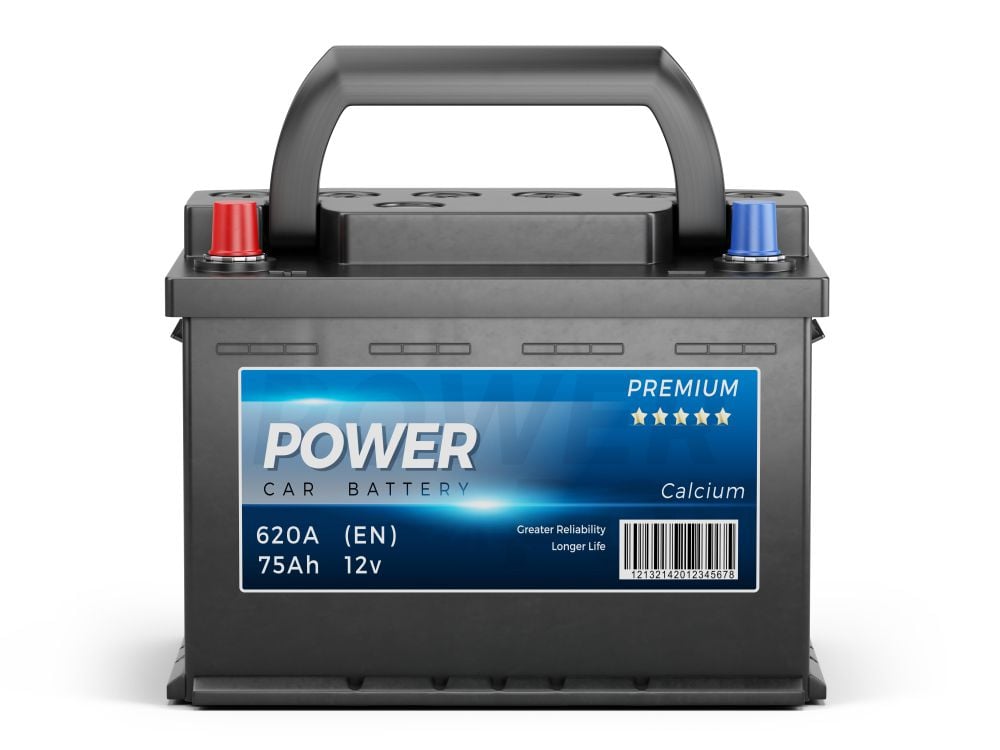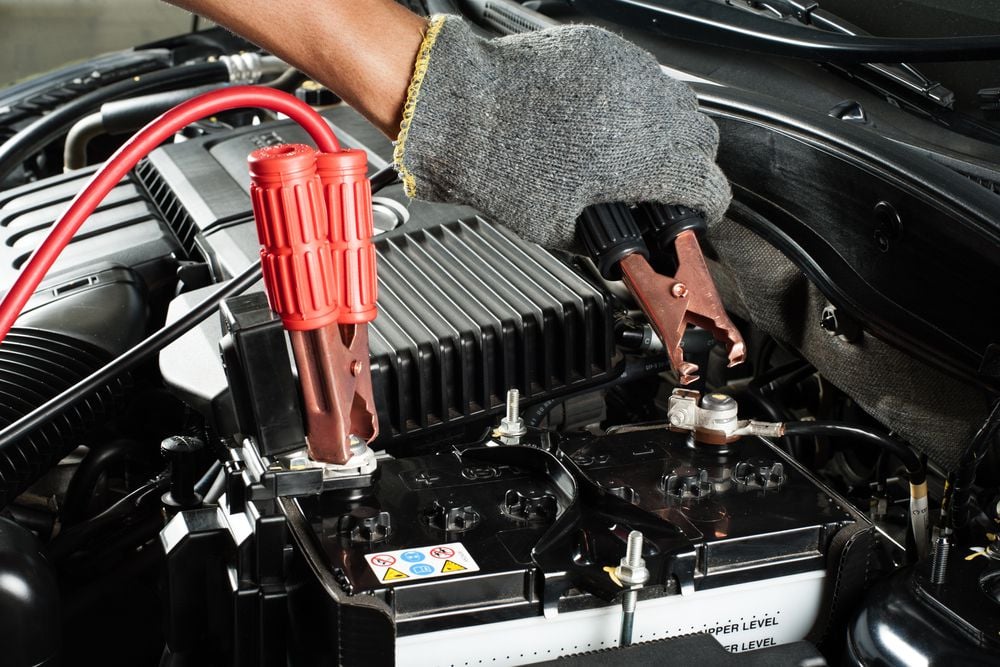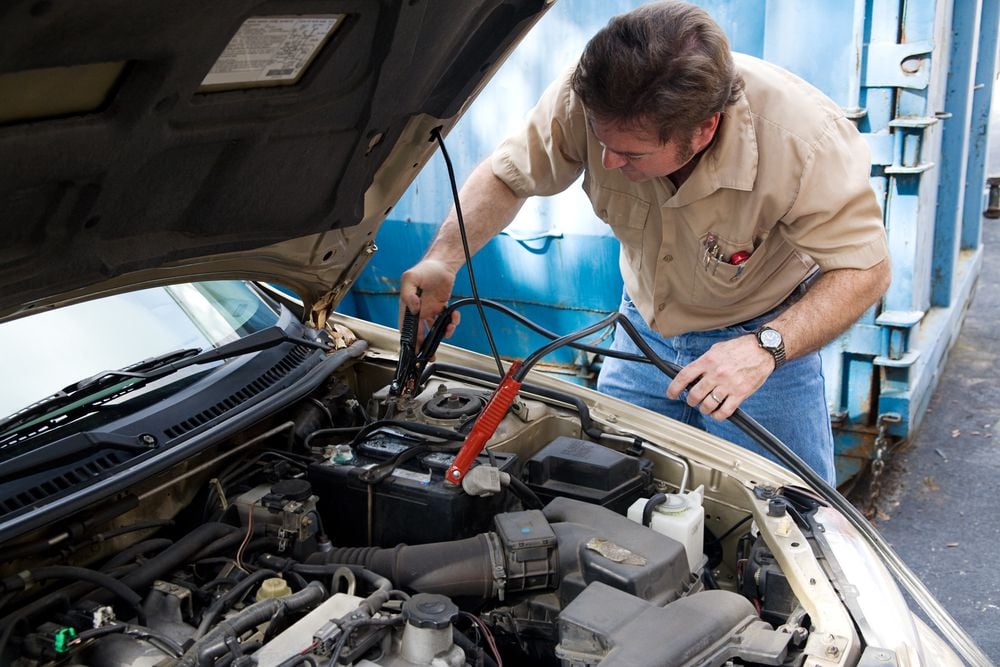Do you need to jump start a dead battery? Or are you just curious about
your car battery? Here's a handy quick guide for figuring out which side of
car battery is positive.
The positive terminal of your car battery will always have a plus sign (+)
marking near it. It will almost always be colored red at the base of the
terminal. The wire attached to the positive terminal will usually also have
a cover with a red plastic body.
The positive and negative sides of a battery are usually easy to tell
apart. It's important to know which one is which, since mixing them up can
be dangerous.
 Car battery with red positive post and blue negative post.
Car battery with red positive post and blue negative post.
Which Side Of The Battery Is Positive And Negative?
The positive and negative terminals are color coded and use different
markings so they are easy to tell apart.
The positive terminal is marked with a plus sign (+) and is colored red.
The negative terminal is marked with a minus sign (-) and is colored black.
A new battery will often have colored felt pads at the base of each of the
battery terminals to help tell them apart. These pads also help prevent
corrosion of the battery cables and posts.
If you are having trouble seeing the colors or markings on your battery,
you can still figure out which is your positive and negative terminal.
Car batteries always have cables that run from the positive terminals to
the starter motor and the alternator. You can trace these cables from your
battery to tell the posts apart.
What Color Is Positive On A Car Battery?
Red is always the color of the positive terminal. Some batteries have
cables that are the same color, but there will usually be some sort of red
coloring somewhere on the positive.
It's very important to know which one is which. If you connect the cables
to the wrong terminals, you can destroy even a good battery.
You also need to be able to tell them apart if you have to use jumper
cables to jump start a dead battery in your car.
Jumper cables will almost always have a red positive cable or a red stripe
on the positive cable. They must be hooked up to the right terminals to
work correctly.
 Jumper cables hooked up to a battery - black clamp on negative and the red clamp on the positive post.
Jumper cables hooked up to a battery - black clamp on negative and the red clamp on the positive post.
Is Black Positive Or Negative On A Battery?
Black is always the color of the negative terminal. The negative always
uses a black cable too.
Are Car Battery Terminals Always On The Same Side?
The two terminals are not always on the same side of the battery.
Some manufacturers will have the positive terminal on the left side, and
the negative terminal on the right side. Others will have them in reverse
order from this.
It's a good idea to rely on the markings and colors on the battery instead
of assuming that the positive side and negative side are always the same.
Positive Or Negative First When Connecting A Battery?
The positive side always needs to be connected first on your vehicle
battery.
The cables must be put on in this order. Otherwise, you can cause sparks
and risk electrocution or causing a fire.
Your car insurance may not cover damage caused from improperly hooking up
your battery.
If you have to jump start a dead battery, jumper cables must always be
hooked to the positive terminal first as well. Hooking to the wrong
terminal can damage the battery.
The negative cable for the dead battery should be hooked to a metal ground,
like an unpainted part of the engine block.
The negative cable for the donor vehicle can be hooked to the negative of
the charged battery.
Do You Connect Red Or Black First?
You always connect the red cable first.
Why Do You Connect Positive First?
The positive post should be hooked up first because there is less risk of
getting shocked or causing sparks.
When you connect the positive cable first, it ensures that the current from
the battery will flow into the cable and not into anything else close to
the battery terminal.
The negative battery cable acts as a ground for the vehicle, and completes
the electrical circuit once it's connected.
If the negative cable is attached first, then the circuit will become live
as soon as anything metal gets close to the positive terminal.
This means that if you accidentally get close to it with a wrench or
anything else metal, you may get shocked.
Why Do You Take The Negative Terminal Off First?
You always take the cable off of the negative battery terminal first in
order to disconnect the ground and break the circuit of the vehicle.
When you take away the electrical ground, the positive cable can be safely
removed without risk of arcing or electrical shock.
 Disconnecting jumper cables from a battery.
Disconnecting jumper cables from a battery.
What Happens If You Remove The Positive Terminal First?
If you remove the positive side first, then your battery may arc from the
terminal to the cable.
This can cause a short circuit that can damage your electronics or cause a
blown fuse in your car. A bad enough short circuit also carries a risk of
causing your battery to explode.
Battery acid is highly corrosive, so this can be extremely dangerous.
Not only that, but the current from the battery may also decide to run
through your body if you touch any other metal surface of your vehicle
while disconnecting the positive side.
Will Car Battery Drain If Negative Cable Disconnected?
Your car battery will begin to slowly drain current if the negative battery
cable is disconnected. This process is known as "self-discharge."
However, the amount that will drain from the battery is only 5 to 15
percent every month it is left unhooked. A fully charged battery can last
for a while like this.
To compare, the amount that is drained from the battery by the electronics
of the car is around 20 percent in a week if the car is not cranked
regularly to recharge the battery.
If you are planning on storing your car for an extended period of time and
don't want to remove the battery, then removing the negative cable is a
good alternative.
Otherwise, you will almost certainly have a dead battery next time you try
to crank your vehicle!
Can I Leave My Car Battery Disconnected Overnight?
You can leave your car battery disconnected overnight without worrying
about a dead battery.
The downside of doing this is that your vehicle electronics will lose all
of their stored information. The battery provides power to all of these
components.
Your car's computer will have to relearn all of its programming, such as
the proper fuel/air mixture and engine timing.
A newer vehicle will also have to relearn things like transmission shift
points, which can cause rough driving while this happens.
Conclusion
Car batteries carry a lot of electrical charge, so it's important to make
sure you handle them correctly and connect them the right way.
With a little basic knowledge, your car can have a good battery with a long
life ahead of it!